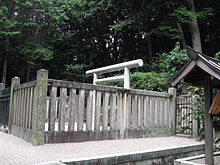Emperor Kōtoku
| Emperor Kōtoku 孝徳天皇 | |||||
|---|---|---|---|---|---|
Saimei | |||||
| Born | Karu (軽) 596 (AD) | ||||
| Died | 654 (aged 57–58) Toyosaki no Miya (Ōsaka) | ||||
| Burial | Ōsaka-no-shinaga no misasagi (大阪磯長陵) (Osaka) | ||||
| Spouse | Hashihito | ||||
| Issue | Prince Arima | ||||
| |||||
| House | Yamato | ||||
| Father | Prince Chinu | ||||
| Mother | Princess Kibitsu-hime | ||||
Emperor Kōtoku (孝徳天皇, Kōtoku-
The years of his reign lasted from 645 through 654 (AD).[3]
Traditional narrative
Before Kōtoku's ascension to the
He was a descendant of Emperor Bidatsu. He was a son of Chinu no ōkimi (Prince Chinu, 茅渟王) by Kibitsuhime no ōkimi (Princess Kibitsuhime, 吉備姫王). Empress Kōgyoku was his elder sister from the same parents. Chinu was a son of Prince Oshisaka hikohito no ōe, whose father was the Emperor Bidatsu. He had at least three consorts including his Empress, Hashihito no Himemiko (Princess Hashihito), the daughter of Emperor Jomei and his sister Empress Kōgyoku. In the 3rd year of Kōgyoku-tennō's reign (皇極天皇三年), the empress abdicated; and the succession (senso) was received by her younger brother. Shortly thereafter, Emperor Kōtoku is said to have acceded to the throne (sokui).[6]
Kōtoku ruled from July 12, 645 (AD),
In 645 he created a new city in the area called
Naka no Ōe held the rank of crown prince and was the de facto leader of the government. In 653 Naka no Ōe proposed to move the capital again to Yamato province. Kōtoku denied. Naka no Ōe ignored the emperor's policy and moved to the former province. Many courtiers of the court, including Empress Hashihito, followed him. Kōtoku was left in the palace. In the next year he died of an illness. After his death, Naka would not ascend to the throne. Instead, his mother and the sister of Kōtoku, the former Empress Kogyoku, ascended to the throne under another name, Empress Saimei.
He enacted the Taika Reform edicts. The system of hasshō kyakkan (eight ministries and a hundred offices) was first established during the reign of Emperor Kōtoku.[8]

The actual site of Kōtoku's
Traditionally the monk
Kugyō
Kugyō (公卿) is a collective term for the very few most powerful men attached to the court of the
In general, this elite group included only three to four men at a time. These were hereditary courtiers whose experience and background would have brought them to the pinnacle of a life's career. During Kōtoko's reign, this apex of the Daijō-kan included:
- Sadaijin, Abe no Kurahashi-maro (阿部倉梯麻呂) (d. 649), 645–649.[11]
- Sadaijin, Kose no Tokoda (巨勢徳太) (593–658), 649–658.[11]
- Udaijin, Soga no Kura-no-Yamada no Ishikawa-no-maro (蘇我倉山田石川麻呂) (d. 649), 645–649.[11]
- Udaijin, Ōtomo no Nagatoko (大伴長徳) (d. 651), 649–651.[11]
- Naidaijin(内臣), Nakatomi Kamako (中臣鎌子) (Fujiwara no Kamatari, 藤原鎌足) (614–669), 645–669.[11]
Eras of Kōtoku's reign
The years of Kōtoku's reign are more specifically identified by more than one
Consorts and children
Empress:
Hi: Abe no Otarashi-hime (阿部小足媛), Abe no Kurahashi-maro's daughter
- Prince Arima (有間皇子, 640–658)
Hi: Saga no Chi-no-iratsume (蘇我乳娘), Soga no Kura-no-Yamada no Ishikawa-no-maro's daughter
Ancestry
| Ancestors of Emperor Kōtoku[13] | ||||||||||||||||||||||||||||||||||||||||||||||||||||||||||||||||||||||||||||||||||||||||||||||||||||||||||||||||||||||||||||||||||||||||||||||||||||||||||||||||||||||||||||||||||||||||||||||||||||||||||||||||||||||||||||||||||||||
|---|---|---|---|---|---|---|---|---|---|---|---|---|---|---|---|---|---|---|---|---|---|---|---|---|---|---|---|---|---|---|---|---|---|---|---|---|---|---|---|---|---|---|---|---|---|---|---|---|---|---|---|---|---|---|---|---|---|---|---|---|---|---|---|---|---|---|---|---|---|---|---|---|---|---|---|---|---|---|---|---|---|---|---|---|---|---|---|---|---|---|---|---|---|---|---|---|---|---|---|---|---|---|---|---|---|---|---|---|---|---|---|---|---|---|---|---|---|---|---|---|---|---|---|---|---|---|---|---|---|---|---|---|---|---|---|---|---|---|---|---|---|---|---|---|---|---|---|---|---|---|---|---|---|---|---|---|---|---|---|---|---|---|---|---|---|---|---|---|---|---|---|---|---|---|---|---|---|---|---|---|---|---|---|---|---|---|---|---|---|---|---|---|---|---|---|---|---|---|---|---|---|---|---|---|---|---|---|---|---|---|---|---|---|---|---|---|---|---|---|---|---|---|---|---|---|---|---|---|---|---|
| ||||||||||||||||||||||||||||||||||||||||||||||||||||||||||||||||||||||||||||||||||||||||||||||||||||||||||||||||||||||||||||||||||||||||||||||||||||||||||||||||||||||||||||||||||||||||||||||||||||||||||||||||||||||||||||||||||||||
See also
- Emperor of Japan
- List of Emperors of Japan
- Imperial cult
Notes
- ^ a b Imperial Household Agency (Kunaichō): 孝徳天皇 (33)
- ^ Ponsonby-Fane, Richard. (1959). The Imperial House of Japan, p. 50.
- ^ Brown, Delmer et al. (1979). Gukanshō, pp. 266–267; Varley, H. Paul. Jinnō Shōtōki. p. 132–133; Titsinh, Isaac. (1834). Annales des empereurs du Japon, pp. 47–30., p. 47, at Google Books
- ^ Brown, pp. 264; prior to Emperor Jomei, the personal names of the emperors (their imina) were very long and people did not generally use them; however, the number of characters in each name diminished after Jomei's reign.
- ^ Ponsonby-Fane, p. 8.
- ^ Titsingh, pp. 47–48; Brown, p. 266; Varley, p. 44; a distinct act of senso is unrecognized prior to Emperor Tenji; and all sovereigns except Jitō, Yōzei, Go-Toba, and Fushimi have senso and sokui in the same year until the reign of Emperor Go-Murakami.
- ^ July 12 645 corresponds to the Fourteenth Day of the Sixth Month of 645 (isshi).
- ^ Varley, p. 133.
- ^ Ponsonby-Fane, p. 420.
- ^ "法道" [Hōdō]. Nihon Jinmei Daijiten (日本人名大辞典) (in Japanese). Tokyo: Shogakukan. 2012. Archived from the original on August 25, 2007. Retrieved October 3, 2012.
- ^ a b c d e Brown, p. 266.
- ^ Titsingh, p. 47.
- ^ "Genealogy". Reichsarchiv (in Japanese). April 30, 2010. Retrieved January 25, 2018.

